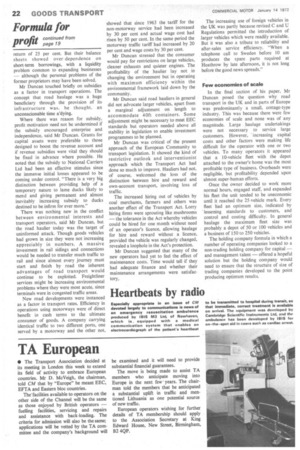Heartbeats by radio
Page 24

If you've noticed an error in this article please click here to report it so we can fix it.
Especially appropriate in an issue of CM devoted largely to communications is news of an emergency resuscitation ambulance produced by IBIS M3 Ltd, of Newhaven, which is, equipped with a medical communication system that enables an electrocardiograph of the patient's heartbeat
The increasing use of foreign vehicles in the UK was partly because revised C and U Regulations permitted the introduction of larger vehicles which were readily available. But it was also a tribute to reliability and after-sales service efficiency. "When a telephone call to Sweden before 10 am produces the spare parts required at Heathrow by late afternoon, it is not long before the good news spreads," Few economies of scale In the final section of his paper. Mr Duncan posed the question why road transport in the UK and in parts of Europe was predominantly a small, cottage-type industry. This was because there were few economies of scale and none was of any magnitude. Large haulage undertakings were not necessary to service large customers. However, increasing capital costs and other factors were making life difficult for the operator with one or two vehicles. To many operators it appeared that a 10-vehicle fleet with the depot attached to the owner's' home was the most profitable type of business. Overheads were negligible, but profitability depended upon almost super-human efforts.
Once the owner decided to work more normal hours, engaged staff, and expanded his fleet the unit tended to be uneconomic until it reached the 25-vehicle mark. Every fleet had an optimum size, indicated by ' lessening standards to customers, and control and costing difficulty. In general haulage the maximum fleet size was probably a depot of 50 or 100 vehicles and a business of 150 to 250 vehicles.
The holding company formula in which a number of operating companies looked to a non-trading holding company for capital — and management talent — offered a hopeful solution but the holding company would need to ensure that the structure of size of trading companies developed to the point producing optimum results.
















































































































